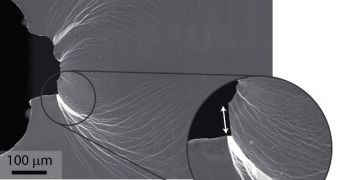A team of researchers from the United States announces the development of a new type of metallic glass that is tremendously damage-tolerant, and which is stronger and tougher than any other material.
In fact, it would appear that stuff is stronger than steel as well. What is even more interesting is that versions of this type of glass are already being developed, and could be made available soon.
Experts from the US Department of Energy (DOE)’s Lawrence Berkeley National Laboratory (Berkeley Lab) worked closely together with colleagues from the California Institute of Technology (Caltech) to create the stuff.
The material is made up of a microalloy of sorts, which contains the metal palladium. The chemical has a very high “bulk-to-shear” stiffness ratio. This means it's easier for it to withstand the brittleness that is characteristic to most glassy materials.
“These results mark the first use of a new strategy for metallic glass fabrication and we believe we can use it to make glass that will be even stronger and more tough,” explains scientist Robert Ritchie.
The expert holds an appointment as a materials scientist at Berkeley Lab. He was also the leader of the researchers that carried out the work on the part of the DOE facility.
“Because of the high bulk-to-shear modulus ratio of palladium-containing material, the energy needed to form shear bands is much lower than the energy required to turn these shear bands into cracks,” he adds.
“The result is that glass undergoes extensive plasticity in response to stress, allowing it to bend rather than crack,” Ritchie says. He is also based at the Materials Sciences Division.
The expert works in the Materials Science and Engineering Department at the University of California in Berkeley (UCB) too. He is one of the co-authors of a new paper describing the research.
The work, entitled “A Damage-Tolerant Glass,” was published in the latest issue of the esteemed journal Nature Materials.
“The rule of thumb is that to make a metallic glass we need to have at least five elements so that when we quench the material, it doesn’t know what crystal structure to form and defaults to amorphous,” Ritchie concludes.

 14 DAY TRIAL //
14 DAY TRIAL //